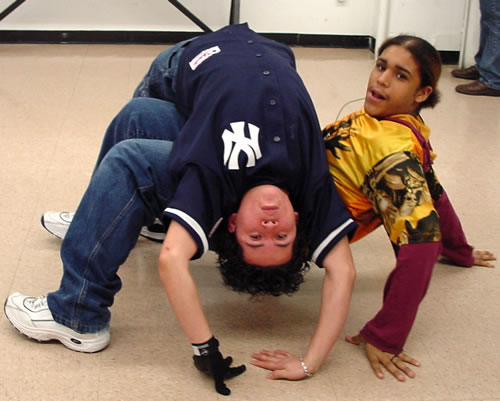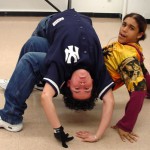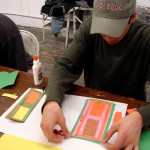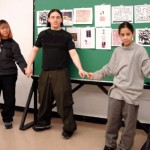
Categories
- Curriculum: Art | Art Criticism | Social Studies | Dance & Music
- Age/Grade: Middle School | Above 14
- Subject: Performance | Writing | Collage | Analysis and Theory
- Materials: Mixed Media | Pencils
- Institution: School of Visual Arts
- Location: New York, New York
- Duration: 3 - 4 Classes
Description
This interactive lesson helps inspire those students who seek to understand their world through music, dance, fashion and popular culture. A totally hip and fun project with extensive teacher notes to follow.
Objective
Familiarity with Keith Haring's artwork and how it pertains to the culture of his time, influences, charities, music and dance.
Vocabulary: Expression, line, repetition, rhythm, complementary color, analogous color...
Visual literacy skills: ability to observe, describe, and interpret works of art.
Analytical Skills: Experience in contemplating various (and sometimes conflicting) data and weighing perception, facts, and opinions in order to make informed judgments.
Deductive Reasoning: Practice at gathering clues, building evidence, and framing formed conclusions.
Creative Expression: Practice at expressing ones objective response to artworks involving reasoning yet open ended.
Individual and Group Communication Skills: Practice at articulating ones ideas and opinions while also learning to listen and respond to others.
Students will realize that varying opinions about art can be discussed and debated.
Resources
Haring web sites
Haring Exhibition catalogs
"Crack is Wack" mural (FDR Drive and 12th St, Manhattan)- more mural locations
"Breakers"
poster- "Dance"
Subway drawings
Stack of people doing the Egyptian with painting and sculpture.
Materials
CD player
TV/VCR
Slips of paper for collage poem
Brown bag
Procedure
MOTIVATION
I will create a club-like environment that Keith was a part of with music that he listened to. Dress up in clothes of that decade. Get break-dancer from the SVA break-dancing club to perform for the students. Break dancers could talk about break dancing, what got them into it, and the history of break dancing. Have the break dancers teach the kids a few moves.
QUESTIONS
1. What's going on in this picture?
2. What makes you say that?
3. Why do you think someone would make a painting out of lines?
4. What type of music do you think the painting is representing?
5. What sounds do you hear when looking at the painting?
PROCEDURE
Setting up before class: (30 mins)
1. Dress up in Eighties clothing.
2. Decorate the room to create an Eighties environment.
3. Set up the CD player and turn on to play songs from the CD.
4. Make sure the room is arranged so that there is enough space for break dancers to perform.
5. Arrange news clippings or magazine covers from the eighties.
Morning
Class time: (1 hour 30 mins)
1. Welcome the class to the Eighties. Introduce yourself as a person from the Eighties. Ask the class what is something unusual that they notice. Talk a little about the clothing and music. Tell students that another thing that was really big in the Eighties was Keith Haring. Lead discussion into break dancing.
2. Introduce break dancers. Break dancers will perform. Afterwards they'll talk about the history of break dancing. They can also talk about how they got started in it.
3. Break dancers will teach the students a few simple break dancing moves.
4. Show the artwork by Keith Haring that is influenced by break dancing to students. Engage in a discussion about the artwork.
6. Wrap up discussion about the Eighties.
Afternoon
Class time (1 hour)
(20 mins) Activity: Collage poem
1. Split class up into groups. Each group will have an image to look at. Each person will write one word on a slip of paper and drop it into a brown bag.
2. Collect bag from the groups. Bags will be redistributed later.
(30 mins) Discussion
3. Asking open-ened style questions, while looking at slides, engage students in a discussion. Purpose of discussion is to talk about Keith's artwork and how it pertains to the culture of his time, influences, charities, music and dance. (There will be more in depth discussion of these topics as the corresponding project is introduced)
(20 mins) Activity: Collage poem
4. After the discussion, students will assemble back together into groups and using the words in the bags, make a poem or a label describing the painting.
SUMMARY
Students will discuss the poem or label that they created for the artwork.
Extensions
NY STATE STANDARDS EMPLOYED
1. Creating, Performing and participating in the arts. Students will create a poem or gallery label for a piece of artwork.
3. Responding and Analyzing Works of Art. Students will actively engage in a class discussion by observing, describing and interpreting artworks by Keith Haring.
The author of this lesson, Wan Ling Li, a student of the School of Visual Arts in NYC, is the 2002-2003 scholarship recipient of the Keith Haring Scholarship award. This project was a collaboration with The School of Visual Arts & The Liberty Partnership Program* in New York City.
To find out more about The Keith Haring Foundation Scholarship offered through the School of Visual Arts, please contact:
Director, School of Visual Arts/Visual Arts Foundation, 15 Gramercy Park South, NYC 10003.
*The Liberty Partnership Program (LPP) is for students enrolled in 5th through 12th grades. LPP targets students who have been identified as being at-risk for dropping out of school because of poor academic performance, truancy, discipline, family circumstances, negative peer pressure and other documented factors.


